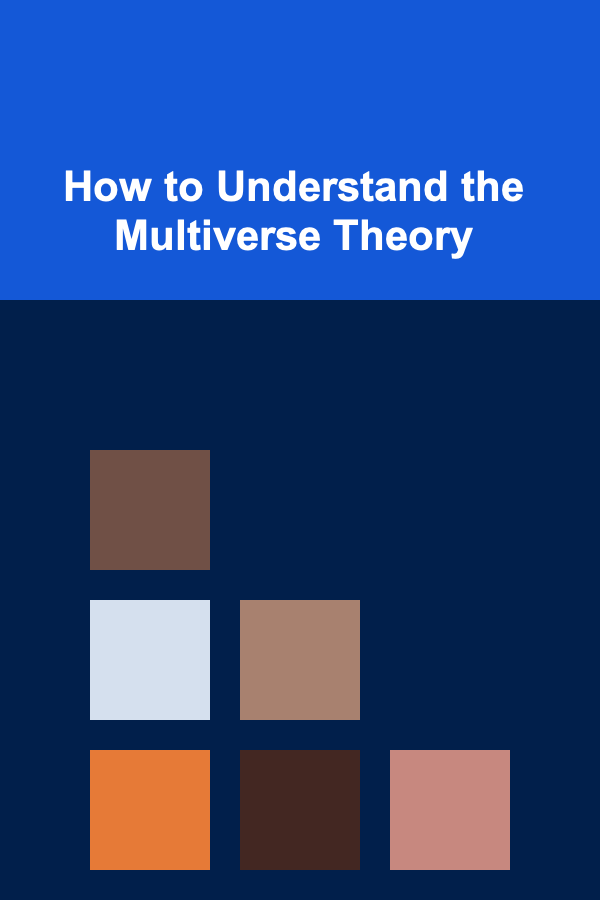
How to Understand the Multiverse Theory
ebook include PDF & Audio bundle (Micro Guide)
$12.99$6.99
Limited Time Offer! Order within the next:

The concept of the multiverse, a term that suggests the existence of multiple universes beyond our own, has long captivated the human imagination. It is a topic that blurs the line between science fiction and serious scientific inquiry, providing a fascinating possibility for the nature of reality. Understanding the multiverse theory requires not only a grasp of physics but also a deep dive into cosmology, quantum mechanics, and the philosophy of science. In this article, we will explore the multiverse theory in depth, discuss the different types of multiverses proposed by scientists, and examine the implications of this theory on our understanding of the universe and reality itself.
The Origins of the Multiverse Concept
The multiverse theory is not an entirely new idea. The earliest forms of the concept can be traced back to ancient philosophies that proposed the idea of parallel worlds or multiple realities. However, in the modern sense, the multiverse theory is largely a product of contemporary physics and cosmology. The term "multiverse" was first used in the 20th century, though its roots are deeper.
Early Foundations in Philosophy
Philosophers such as Plato and Aristotle considered ideas of multiple worlds or universes in their works, though not in the context of modern scientific theories. Their musings were speculative and largely metaphysical. It was only with the advent of modern physics and cosmology that the multiverse concept began to be taken more seriously as a scientific hypothesis.
The Birth of Modern Multiverse Theory
In the 20th century, the multiverse theory began to take shape within the framework of cosmology and quantum mechanics. One of the first modern attempts to seriously consider the multiverse idea came from Hugh Everett's "Many-Worlds Interpretation" (MWI) of quantum mechanics, which was proposed in 1957.
Everett's theory was a radical departure from the traditional Copenhagen interpretation of quantum mechanics, which posited that a quantum system existed in a superposition of states until it was observed. Everett suggested that all possible outcomes of a quantum event occur, each in its own separate universe. This was the first conceptual leap towards what we now call the "multiverse."
Simultaneously, the field of cosmology was developing, with the discovery of the expanding universe and the formulation of the Big Bang theory. As scientists explored the structure of the universe, the idea that our universe might be just one of many began to take hold.
Types of Multiverses
While the idea of multiple universes has become a fascinating theoretical notion, it's essential to note that there is no single definition of what a "multiverse" is. Depending on the theoretical framework, there are many different versions of the multiverse, each offering different possibilities for what might exist beyond our universe. Below are some of the most prominent types of multiverses that have been proposed by scientists.
1. The Bubble Multiverse (or "Level I Multiverse")
The concept of a bubble multiverse arises from the theory of cosmic inflation, which suggests that the universe underwent a rapid, exponential expansion in the first fraction of a second after the Big Bang. This inflationary model implies that the universe could be much larger than we can currently observe, potentially containing infinite regions that are similar to our own observable universe.
Each of these regions could, in principle, be considered a separate "bubble" or "pocket" universe, each with its own distinct laws of physics. In this model, the fundamental constants and physical properties of each bubble could vary, and these bubbles could even evolve independently of one another.
2. The Quantum Multiverse (or "Level II Multiverse")
The quantum multiverse theory stems from the many-worlds interpretation of quantum mechanics, proposed by Hugh Everett. In quantum mechanics, particles can exist in a superposition of states, and only when a measurement is made do they "collapse" into a definite state. According to Everett, all possible outcomes of a quantum event actually occur, each in a separate branch of the universe.
For example, in a typical quantum scenario, when a particle can be in one of two states (e.g., spin up or spin down), the universe splits into two branches: one in which the particle is spin-up, and one in which it is spin-down. The multiverse, in this case, is composed of all the possible outcomes of quantum events, with each outcome corresponding to a separate, non-interacting universe.
This model suggests a vast number of parallel universes, each arising from different quantum events. The quantum multiverse is often thought of as the most radical and mind-bending form of the multiverse theory because it implies that every decision we make, and every possibility, leads to a new branch in the cosmic tree of reality.
3. The String Theory Multiverse (or "Level III Multiverse")
String theory, a leading candidate for a theory of quantum gravity, suggests that the fundamental building blocks of reality are not point-like particles but rather one-dimensional "strings" that vibrate at different frequencies. String theory has led to the idea of a multiverse, particularly through its concept of "landscape" solutions.
The string theory landscape is a vast collection of possible vacuum states of the universe, each with different physical properties and constants. These vacua represent different ways the universe could be structured based on the values of the fundamental forces, such as gravity and electromagnetism. According to string theory, there are an incredibly large number of possible vacua, possibly more than 10^500 different possibilities. Each vacuum could correspond to a different universe, leading to a "multiverse" of possibilities.
This version of the multiverse suggests that the universe we observe is just one of many possible universes, each with its own set of physical laws and constants. Some universes might be radically different from our own, while others might be very similar, but with slight variations.
4. The Mathematical Multiverse (or "Level IV Multiverse")
The mathematical multiverse theory, proposed by physicist Max Tegmark, is the most abstract and far-reaching of the multiverse models. Tegmark's hypothesis is based on the idea that all mathematically consistent structures exist in a physical sense. In this view, any mathematical structure that is logically consistent could represent a universe.
Tegmark divides the multiverse into four levels, with Level IV being the most abstract. At this level, the multiverse consists of all possible mathematical structures, each representing a different "universe" in a broader sense. These universes may not even be made of matter, but instead could be purely mathematical in nature.
According to the mathematical multiverse theory, all conceivable forms of reality exist as long as they can be described mathematically, even if those realities have no direct correspondence to anything we perceive in our own universe. This idea challenges the very definition of what it means to be "real" and pushes the boundaries of physical science into pure mathematical abstraction.
5. The Parallel Universes of Cosmology
While the bubble multiverse and the quantum multiverse focus on theoretical physics and quantum mechanics, there are also cosmological models of the multiverse. One prominent theory in this category is the "eternal inflation" model, which posits that the universe is constantly inflating, creating new regions of space-time that continue to expand. This results in a "multiverse" of regions with different physical properties.
In some variations of this theory, certain regions of space-time may develop in ways that are entirely independent of others. This can lead to the creation of new universes, with different laws of physics or constants. These universes may even coexist alongside ours, though they are entirely disconnected and invisible from our perspective.
Implications of the Multiverse Theory
The multiverse theory carries profound implications for the way we understand reality and the universe we inhabit. If the multiverse exists, it would change our perspective on many aspects of cosmology, physics, and even philosophy. Below are some of the key implications of the multiverse theory:
1. The Fine-Tuning Problem
One of the most compelling reasons for considering the multiverse theory is the "fine-tuning" of the universe. The constants and laws of physics in our universe appear to be finely tuned for the existence of life. Small changes in the values of these constants could result in a universe that is inhospitable to life as we know it.
The multiverse theory offers a potential explanation for this fine-tuning. If there are many universes, each with different laws of physics, it is not surprising that we happen to live in one that supports life. This is sometimes called the "anthropic principle," which suggests that we observe the universe in a way that is conducive to life simply because we exist.
2. The Nature of Reality
The multiverse theory challenges our fundamental understanding of reality. If there are infinite universes, each with its own set of physical laws, what does it mean for something to be "real"? The idea that there could be countless versions of ourselves in parallel universes, living out different outcomes, raises deep philosophical questions about the nature of self, identity, and the concept of fate.
3. Testability and Falsifiability
One of the most significant challenges facing the multiverse theory is its lack of empirical testability. Because the universes in many multiverse models are inaccessible to us, it is difficult, if not impossible, to test these theories using current scientific methods. This raises important questions about the role of science in exploring ideas that may never be directly observable or testable.
Critics of the multiverse theory argue that it may fall into the realm of speculative metaphysics rather than empirical science. However, proponents of the theory point out that many scientific theories, such as the Big Bang and quantum mechanics, were once untestable but eventually became the cornerstone of modern physics.
4. The End of the "Specialness" of Our Universe
If the multiverse theory is true, it would fundamentally alter our perception of the universe. The idea that there are potentially infinite universes would undermine the notion that our universe is uniquely special or central. This could lead to a shift in our philosophical and existential understanding of humanity's place in the cosmos.
5. New Frontiers in Physics
Finally, the multiverse theory presents exciting new possibilities for the future of physics. If we could find a way to test or observe other universes, it could open up entirely new fields of research and discovery. Concepts such as parallel realities, alternate histories, and different laws of physics could revolutionize our understanding of everything from time travel to the ultimate fate of the universe.
Conclusion
The multiverse theory is one of the most fascinating and mind-bending concepts in modern science. While it remains largely speculative and untested, it challenges our understanding of reality, the universe, and the nature of existence itself. Whether we will ever have definitive evidence for the multiverse remains to be seen, but the idea has already sparked deep discussions in physics, cosmology, and philosophy.
As our knowledge of the cosmos continues to expand, so too does our capacity to consider new and unconventional ideas about the universe. The multiverse theory invites us to imagine a reality far larger and more complex than we have ever thought possible. Whether or not it is ultimately proven, the multiverse continues to inspire wonder and curiosity about the boundless potential of the cosmos.

Affordable and Enjoyable Budget-Friendly Home Entertainment Ideas on a Tight Budget
Read More
Generating Passive Income with AI-Driven Applications
Read More
How to Create a Magical Holiday Entrance with Lights and Decor
Read More
How to Reduce Your Risk of Chronic Diseases with Food
Read More
How to Create Compelling Social Media Stories
Read More
How to Negotiate Your Salary as a Freelancer
Read MoreOther Products

Affordable and Enjoyable Budget-Friendly Home Entertainment Ideas on a Tight Budget
Read More
Generating Passive Income with AI-Driven Applications
Read More
How to Create a Magical Holiday Entrance with Lights and Decor
Read More
How to Reduce Your Risk of Chronic Diseases with Food
Read More
How to Create Compelling Social Media Stories
Read More